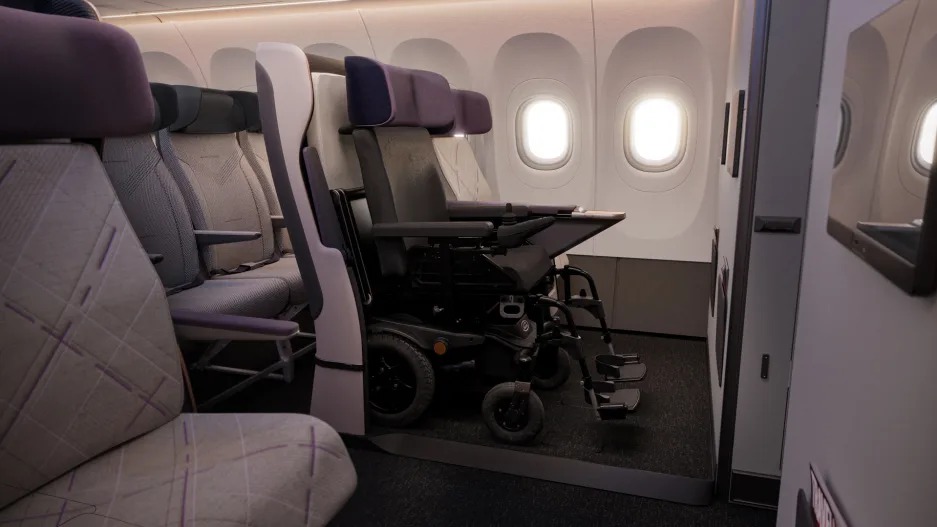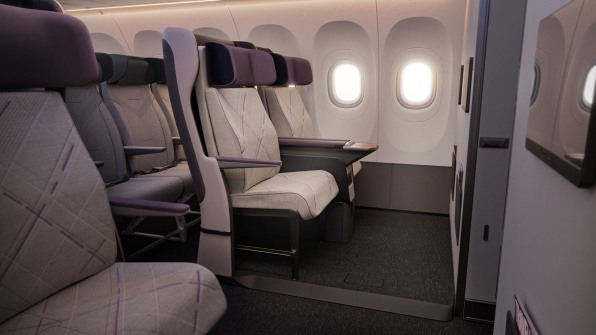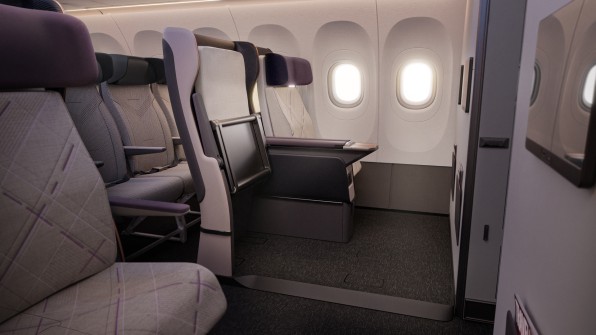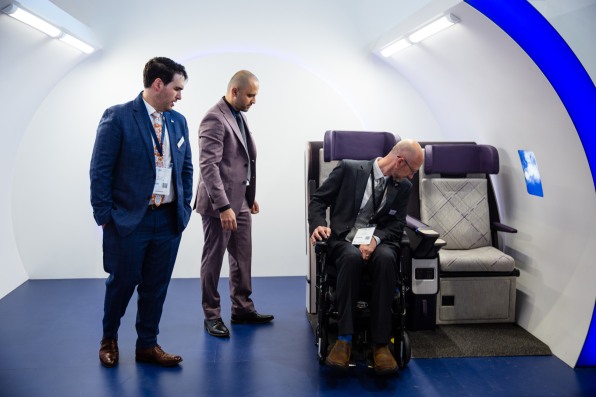- | 8:00 am
This airplane seat for wheelchairs users is simple and ingenious
A new cabin design that lets wheelchair users keep their mobility device while traveling is one step closer to being a reality.

Air travel is one step closer to being accessible.
Delta Flight Products, a subsidiary of Delta Airlines, has revealed a working prototype for its wheelchair-friendly cabin that allows people to stay in their wheelchairs for the duration of the flight. A first of its kind for the airline industry, the cabin was designed by a consortium called Air 4 All, comprised of PriestmanGoode, a design consultancy known for its innovative transport designs; the advocacy organization Flying Disabled; wheelchair manufacturer Sunrise Medical; and SWS Certification, which specializes in getting airplane products like seating and cabin interiors approved.

The proposal, which essentially turns wheelchairs into airplane seats, complete with a headrest and tray table, has been in the works since 2020. But this is the first time a working prototype is being unveiled to the public, together with an official partner in Delta Flights Products. It’s an important—and long overdue—step to ensuring air travel is accessible to everyone.
Currently, airplanes are the only mode of public transport that forces people to give up their wheelchairs for the duration of the trip, which can turn the experience of flying into an ordeal. “Whenever either my son or daughter travel by air, it is a complex—and many would say—a military maneuver just to be able to access the cabin of an aircraft,” Chris Wood, a director at Flying Disabled, who has two grown children in wheelchairs, said via email. “Once in the seat, it is also not suitable for their posture.”
People who use wheelchairs often go through a distressing and intrusive process because their wheelchair cannot fit on the airplane. Currently, airlines require people to use an airport-issued wheelchair to first just get to the plane, where they must transfer to an airline-issued wheelchair to reach their seat, which, Wood notes, offers zero posture support compared to a power wheelchair and can give people sores on long-haul flights.
If that weren’t enough, many wheelchairs can get lost or broken in transit, too. According to the most recent Air Travel Consumer Report, U.S. airlines mishandled more than 11,000 wheelchairs and scooters last year, or about 1.5% of the total that was loaded on the plane.

A new cabin design could change all that. The team has redesigned the first two aisle seats of a Boeing 737. When there are no wheelchair users onboard, the seats look and function like standard seats. But when a wheelchair passenger boards the plane, the back of the chair can be removed, the seat and armrest fold up, and the wheelchair user can back right into that negative space. “We wanted to make it feel like the airline is buying a product where you don’t really know it’s a disabled-access seat,” says Daniel MacInnes, director of PriestmanGoode. “When you fold it up, it makes the passenger in the wheelchair feel like they’re in this seat like everybody else and not made to feel like they’re in a unique product.”

In business terms, this design means accessibility doesn’t come at a cost to the airlines, who have been hesitant to leave a dedicated space for wheelchair users. “If we can make product that can be adapted in that space, it means the revenue for the airline is not affected,” says MacInnes.
The design of the seat takes its cues from the kind of folding chair found at a movie theater. Once the seat and armrests are folded, the wheelchair can slot right in with the assistance of a crew member who attaches the wheelchair to a latch on the floor. The setup takes about 2 to 3 minutes, which lets the crew prepare the cabin on a short turnaround, and requires the same kind of training as with any new aircraft seat.
Once in their seat, people can use the plane’s headrest, tray table, and power plugs as usual. But apart from the restroom, which remains inaccessible and would require a transfer to an airline-issued wheelchair, the updated cabin offers much more independence for people in wheelchairs.

For now, the design only works for electric-powered wheelchairs, which the team chose because they help people with the most challenging disabilities. It will also only be available for Business Class passengers, and in a narrow-body plane. But the team is working to expand on all of these categories so that they can provide accessible seating for Economy Class passengers, in any type of plane, and for any type of wheelchair.
The prototype, which was recently displayed at the Aircraft Interiors Expo in Hamburg, isn’t likely to be fully certified for another 18 months or so, and no airline has been confirmed as a first partner (despite being a Delta subsidiary, Delta Flight Products is an independent company that works with various airlines). Before that happens, the team needs to obtain a certification for the current prototype. After that, the product will be available to any airline that wants it. “The product is not meant to be for one airline,” says MacInnes. “It’s meant to be for the industry, and it’s trying to promote something that makes accessibility onto an aircraft the norm.”





































